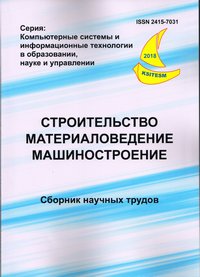Methodology of the process design of gross product output of an enterprise
DOI:
https://doi.org/10.30838/P.CMM.2415.270818.151.246Keywords:
gross product, dynamic programming, quadratic functional of quality, weight factors, design parameters, optimal filterAbstract
The methods for designing the process of gross product output of an enterprise, based on the stochastic method of dynamic programming for continuous deterministic systems was created. The selection of weight factors of quadratic quality functional was substantiated, the dependence between parameters of design and weight factors was established, and the region of optimum values of design parameters was determined, the optimal filter of the process of gross product output of an enterprise was obtained. Modeling of the process of gross product output with optimum values of coefficients of growth and retirement of basic production assets. Production capacity is determined by the output at the achieved level of organization and production technology. The shape of production capacity graphs changes noticeably even with minor changes in parameters, i.e., capacity is sensitive to changes in the state of a firm. Design parameters are determined by the matrix method of dynamic programming. Based on the concepts of observability and controllability, it has been established that the process of producing a gross product of an enterprise is subject to management. By modeling and calculations, it was proved that using the matrix method of dynamic programming, one can obtain analytical dependencies for growth and retirement coefficients, as well as calculate the regions of their optimal values, i.e. The production capacity of an enterprise can be the main indicator of the characteristics of the life cycle of an enterprise. The technique should be used when designing the process of producing a gross product of enterprises, its implementation will reduce the design time and ensure the stability of the process of producing a gross product.References
Yershova N.М. Sovremennyye metody teorii proyektirovaniya i upravleniya slozhnymi dinamicheskimi sistemami [Modern methods of the theory of design and control of complex dynamic systems]. Dnipropetrovsk: PGASA, 2016, 272 p. Available at: https://search.rsl.ru/ru/record/01008879909 (in Russian).
Sirazetdinov Т.K. Dinamicheskoe modelirovaniye ekonomicheskikh obyektov [Dynamic modeling of economic objects]. Kazan: Fun, 1996, 223 p. Available at: https://search.rsl.ru/ru/record/01001758401 (in Russian).
Shibko О.N. Vybor osnovnogo pokazatelia kharakteristiki zhiznennogo tsikla stroitelnoy firmy [Selection of basic indicator of characteristic of the life cycle of a construction company]. Materials of the 2nd International scientific and practical conference “Days of science – ‘2006”. – Dnipropetrovsk: Nauka i osvita [Science and education], Volume 7: Economic sciences. 2006, pp. 95-97. (in Russian).
Lindkvist L., Sundin E. The role of Product-service Systems Regarding Information Feedback Transfer in the Product Life-cycle Including Remanufacturing. Procedia CIRP, 2016, № 47, pp. 311-316.
Mahut F., Bricogne M. and Daaboul J. Servicization of Product Lifecycle Management: towards Service Lifecycle Management. IFIP International Conference on Product Lifecycle Management. Springer International Publishing 2015, pp. 321-331.
Peruzzini M., Germani M. and Marilungo E. A sustainability lifecycle assessment of products and services for the extended enterprise evolution. IFIP AICT, 2013, no. 409, pp.100-109.
Schmidt D. M., Preißner S. and Hermosillo Martínez J. A. Integration of user knowledge across the lifecycle of integrated product-service systems–an empirical analysis of the relevance for PSS development and management. DS 80-9 Proceedings of the 20th International Conference on Engineering Design (ICED 15) 2015, Vol 9: User-Centred Design, Design of Socio-Technical systems, Milan, Italy, pp. 27-30. (in Italy).
Sundin E. Life-cycle perspectives of product/service-systems: in design theory. Introduction to product/service-system design. Springer London, 2009, pp. 31-49. (in England).
Wang P., Ming X., Li D., Kong F., Wang L. and Wu Z. Status review and research strategies on product-service systems. International Journal Of Production Research. 2011, no. 49, pp. 6863-6883.
Wiesner S., Freitag M., Westphal I. and Thoben K. Interactions between Service and Product Lifecycle Management. Procedia CIRP. 2015, no. 30, pp. 36- 41.
Westphal I., Freitag M. and Thoben KD. Visualization of interactions between product and service lifecycle management. IFIP AICT, 2015, no. 460, pp.575- 582.
Downloads
Published
Issue
Section
License
Редакція Видання категорично засуджує прояви плагіату в статтях та вживає всіх можливих заходів для його недопущення. Плагіат розглядається як форма порушення авторських прав і наукової етики.
При виявлені у статті більш ніж 25% запозиченого тексту без відповідних посилань та використання лапок, стаття кваліфікується як така, що містить плагіат. У цьому випадку стаття більше не розглядається редакцією, а автор отримує перше попередження.
Автори, в статтях яких повторно виявлено плагіат, не зможуть публікуватися в усіх журналах Видавництва ДВНЗ «Придніпровська державна академія будівництва та архітектури».
Автори, які публікуються у цьому журналі, погоджуються з наступними умовами:
- Автори залишають за собою право на авторство своєї роботи та передають журналу право першої публікації цієї роботи на умовах ліцензії Creative Commons Attribution License, котра дозволяє іншим особам вільно розповсюджувати опубліковану роботу з обов'язковим посиланням на авторів оригінальної роботи та першу публікацію роботи у цьому журналі.
- Автори мають право укладати самостійні додаткові угоди щодо неексклюзивного розповсюдження роботи у тому вигляді, в якому вона була опублікована цим журналом (наприклад, розміщувати роботу в електронному сховищі установи або публікувати у складі монографії), за умови збереження посилання на першу публікацію роботи у цьому журналі.
- Політика журналу дозволяє і заохочує розміщення авторами в мережі Інтернет (наприклад, у сховищах установ або на особистих веб-сайтах) рукопису роботи, як до подання цього рукопису до редакції, так і під час його редакційного опрацювання, оскільки це сприяє виникненню продуктивної наукової дискусії та позитивно позначається на оперативності та динаміці цитування опублікованої роботи (див. The Effect of Open Access).

